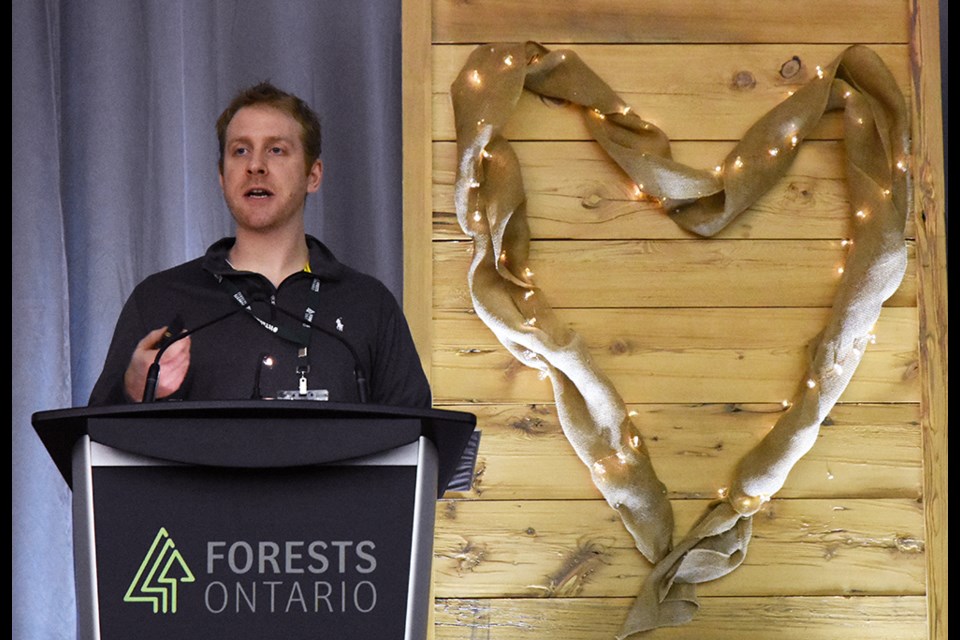Stefan Weber has been a seed collector for the past 17 years, helping to preserve rare and at-risk species of native plants by gathering seed in a sustainable manner for cultivation.
He has also been part of the effort to find environmentally sensitive ways to control a growing problem in Ontario and across North America: the spread of the invasive phragmites australis, the common reed.
Weber is the founder of the Ontario Plant Restoration Alliance, and a graduate student at McMaster University. At the recent Forests Ontario Conference, he described the collaborative networks that have been established to ensure a supply of seeds for naturalization and habitat restoration projects.
And he described a project involving phragmites.
Weber received funding from the Ministry of Transportation for a unique restoration project: to find a solution to prevent new outbreaks of phragmites along highways.
Phragmites australis is native to Eurasia. Introduced to North America, it has become a threat to biodiversity and Ontario’s wetlands, forming vast stands, and suppressing the growth of native species.
The reed can grow to nearly five metres in height, clogging ditches, blocking sightlines and creating a fire hazard along roads.
Weber was tasked with looking for native plants that could co-exist and potentially compete with phragmites in roadside ditches.
He experimented with 12 different native plants and found that bidens species (tickseeds) and seaside goldenrod (native to North America, but not Ontario) were “the best things you can plant.”
Both were tolerant to the high salt levels in roadside ditches, and could compete with phragmites, but only when the reed was germinated from seed, and not from root fragments.
“Phragmites can go from root fragment to tree in no time,” Weber said.
The results of his experiments were “mixed, but not hopeful,” he admitted, for the control of the invasive phragmites.
The Town of Innisfil has taken a different approach to controlling phragmites.
Innisfil partnered with the County of Simcoe to undertake a three-year pilot project, spraying stands of phragmites along road allowances with Roundup WeatherMAX (containing the controversial ingredient glyphosate), and an MSO concentrate containing methylated soybean oil.
More than 300 stands of phragmites were identified along roadsides in Innisfil. Spraying was only permitted on municipally owned land and only when there was no standing water.
The first year of the program was 2018. It wasn’t until the spring of 2019 that the town could observe the effects of the spraying and whether it had been successful.
“The majority of the locations that were treated the year before did not regrow phragmites the following year,” said Jeremy Nyenhuis, Innisfil’s stormwater project manager.
However, regrowth was seen outside of the sprayed areas, and in patches that were only partially on municipal land and therefore only partially treated.
The pesticides seemed to be successful in killing both the plant and its roots, which are the key to its aggressive spread.
In fact, in 2019 the contractor found no reason to reapply the pesticide to a number of the phragmites stands, which showed no signs of regrowth.
One of the most positive observations? “There was a slight regrowth of native species in 2019,” in some of the sprayed areas, Nyenhuis said.
This will be the final year for the three-year pilot.
“This summer, I hope to go out and inspect all the treated and untreated locations in order to provide an update on the effectiveness of the project,” Nyenhuis said, determining if areas sprayed in 2018 are still phragmites-free two years later and if native species are showing signs of recolonizing the sites.
Then it will be up to town council to decide if the spraying program will continue, as the search for a solution to the spread of the invasive species continues.

.png;w=120;h=80;mode=crop)

